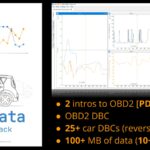Many Integra enthusiasts consider converting their OBD2 system to OBD1, but the reasons behind this modification are often misunderstood. This article clarifies the purpose of an OBD2 to OBD1 conversion in Integra vehicles, focusing on the key benefit: advanced engine tuning. We’ll delve into why this conversion is primarily for those looking to maximize their engine’s performance through custom tuning, and when it’s actually necessary.
Why Convert to OBD1? The Tuning Advantage
The primary motivation for switching from OBD2 to OBD1 lies in the enhanced tuning capabilities offered by OBD1 systems for older Honda and Acura vehicles like the Integra. OBD1 engine control units (ECUs) are significantly more accessible and customizable for performance tuning compared to their OBD2 counterparts.
When you modify your engine for greater performance, whether naturally aspirated or forced induction (turbocharged or supercharged), the factory OBD2 ECU often falls short. A stock ECU is programmed to maintain factory settings, which may not be optimal for a modified engine requiring different air-fuel ratios and ignition timing. This is where OBD1 and custom tuning become invaluable.
OBD1 ECUs, particularly when used with aftermarket tuning solutions, allow for precise control over critical engine parameters. You gain the ability to create a custom engine map, adjusting air-fuel ratios, ignition timing, and even features like VTEC engagement points, rev limits, and launch control. This level of control is crucial for optimizing performance and driveability in a modified Integra, ensuring the engine operates at its peak efficiency and power output across all conditions. The goal of effective tuning is to maintain the ideal air-fuel ratio at all times, something a stock OBD2 ECU simply isn’t designed to do on a heavily modified engine.
OBD2 Strengths: Superior Diagnostics
While OBD1 excels in tuning flexibility, OBD2 systems offer a significant advantage in diagnostics. OBD2 is equipped with a greater number of sensors compared to OBD1. These sensors provide the ECU with a more comprehensive view of the engine’s operation, allowing for more precise and detailed error detection.
In practical terms, when an issue arises, an OBD1 system might only report a generic “EFI error.” This broad error code leaves you to troubleshoot a wide range of potential problems, from the fuel pump to the injectors, potentially wasting hours in diagnosis. Conversely, OBD2 systems provide much more specific diagnostic trouble codes (DTCs). For example, instead of a generic EFI error, OBD2 might pinpoint “Fuel control, #2 cylinder.” This precise information significantly reduces troubleshooting time, often cutting it down to minutes instead of hours by directing you straight to the likely source of the problem.
Alt text: Close-up of an OBD2 port in a vehicle interior, highlighting the diagnostic interface for modern cars.
Tuning Necessity Drives the Conversion
It’s crucial to understand that converting to OBD1 solely for the sake of conversion offers no inherent benefit. The conversion is specifically driven by the need for engine tuning. If you are not planning to tune your Integra’s engine, there is no compelling reason to switch to OBD1. In fact, running a factory OBD1 ECU in an OBD2 car without proper tuning can lead to driveability issues due to sensor mismatches and incorrect fuel and ignition maps for your specific engine configuration.
Therefore, the question isn’t simply “OBD2 or OBD1?”, but rather “Do I need to tune my Integra for performance?”. If the answer is yes, and you are working with an older Integra model where OBD1 tuning solutions are more readily available and cost-effective, then the OBD2 to OBD1 conversion becomes a necessary step in the performance tuning process.
Simplified Conversion: OBD2 to OBD1 Harness
The OBD2 to OBD1 conversion is made surprisingly straightforward thanks to readily available conversion harnesses. Forget about splicing or cutting wires – these harnesses are designed for a plug-and-play installation. Simply search online for “OBD2 conversion harness” for your Integra model, and you’ll find numerous options. These harnesses directly connect to your factory OBD2 connectors and adapt them to plug into an OBD1 ECU. This eliminates the complexity and potential risks associated with manual wiring, making the conversion process accessible even for DIY enthusiasts.
Alt text: An OBD2 to OBD1 conversion harness kit displayed on a workbench, showcasing the connectors and wiring required for a simple ECU swap.
OBD1 Tuning Options: Chipped, Hondata, and Standalone ECUs
Once you’ve converted to OBD1, you unlock a range of tuning options to optimize your Integra’s performance. The most common and effective methods include:
- Chipped ECUs: These involve modifying a stock OBD1 ECU by installing a chip that contains a custom tune. This is a budget-friendly option for basic tuning needs.
- Hondata: Hondata is a popular and highly regarded tuning solution for Honda and Acura vehicles. They offer systems like S300 and KPro that provide extensive tuning capabilities while retaining many of the factory ECU’s functionalities. Hondata is often considered the sweet spot for street performance builds, offering a balance of features, user-friendliness, and cost.
- Standalone ECUs (AEM, etc.): Standalone ECUs, such as those from AEM, offer the ultimate level of tuning control and flexibility. However, they are typically more complex to install and tune, and are generally reserved for highly modified engines and race applications. For most street-driven Integra builds, a standalone ECU is often overkill.
For most Integra owners seeking performance gains for street use, Hondata systems provide the ideal balance of advanced tuning capabilities without the complexity and expense of a full standalone ECU.
Conclusion: Tuning is the Deciding Factor
In summary, the OBD2 to OBD1 conversion in an Integra is primarily undertaken to facilitate advanced engine tuning. While OBD2 offers superior diagnostic capabilities, OBD1 provides the necessary access and flexibility for custom ECU mapping required to optimize performance in modified engines. If you’re aiming to extract maximum power and refine the driveability of your modified Integra, particularly through aftermarket tuning solutions like Hondata, then an OBD2 to OBD1 conversion is a worthwhile and often essential modification. However, if you’re not planning on tuning your engine, sticking with the OBD2 system and its enhanced diagnostic features is generally recommended.

